Google Introduces Us To Ice Cream Sandwich
by Jason Inofuentes on October 18, 2011 11:06 PM EST- Posted in
- Smartphones
- Android
- Ice Cream Sandwich
- Mobile
When I said it would be a busy fall, I didn’t expect us to be covering two big announcements in one day, or three/four/five, depending on how you choose to count them. Samsung didn’t just show off new hardware, Google was there to show off the new software behind that hardware. Details of Android 4.0 Ice Cream Sandwich have been leaking for some time now but with the SDK published and the event wrapped up we have a better sense of what Google has in mind for the next phase in Android. Let’s get started.
Matias Duarte started off by introducing the audience to Android’s new font, Roboto. Playful though the name is, it is a stylish and elegant font, and while it might not strike the right note for everyone it certainly seems easy to read. It’s featured throughout ICS, including the digital clock on the lock screen which is where we’ll begin. The layout is familiar, and not too divergent in look. In function there’s some new tricks to show off. Swiping the unlock icon to the right takes you to your home screen, though swiping left takes you to the camera app, more on that in a bit. This trick has been seen before, most recently in HTC’s Sense 3.5. New - though perhaps not as revolutionary - is facial recognition based unlock, which Google aptly calls Face Unlock. This was a feature in my Lenovo S10 from several years back, and judging by the demo this implementation may face the same hurdles as that Lenovo, poor lighting leads to poor recognition. This may pan out, though right now it seems like a solution searching for a problem.
The gold standard for notifications systems has been WebOS since its introduction, with Android following close behind. In its latest incarnation the differences are mainly cosmetic and in the addition of a music notification with playback controls and the ability to swipe away individual notifications. These are features that we’ve seen in skinned and modded versions of Android for some time, but welcome nonetheless. What we haven’t seen is the ability to peek at notifications from the lock screen and then go directly into the app that originated the notification upon unlock.
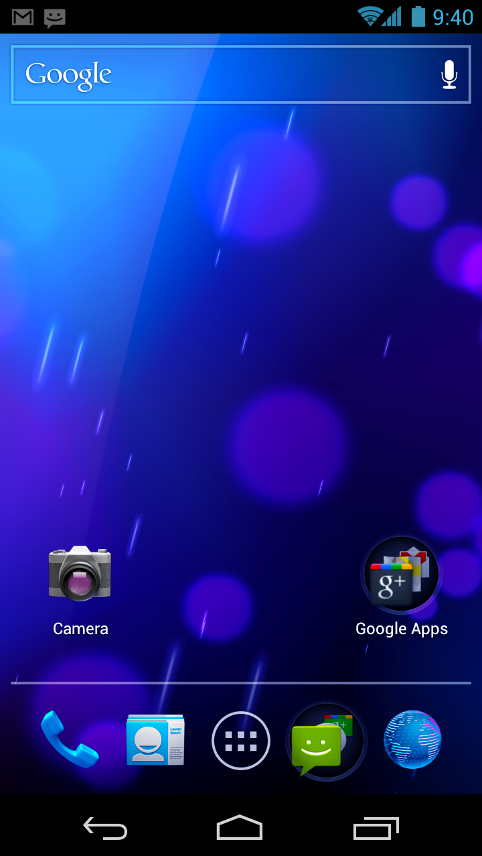
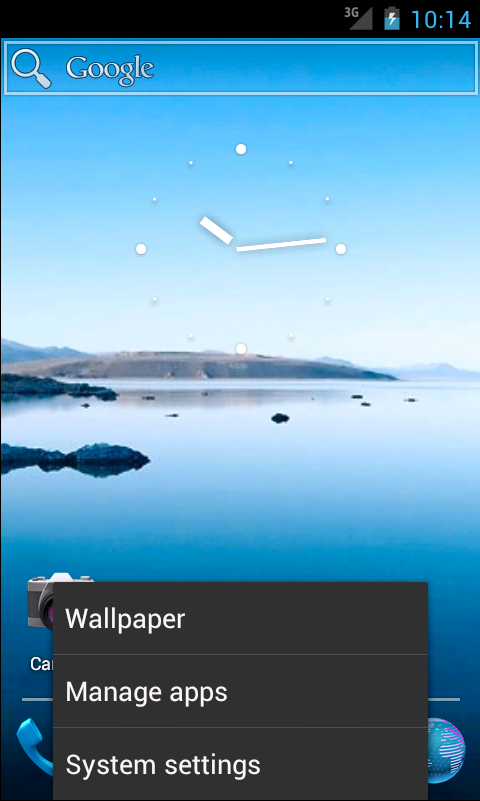
Having unlocked your phone you are now presented with a home screen that looks like a comfortable marriage between Honeycomb and Gingerbread. Honeycomb’s on screen buttons have evolved and are delightfully animated, and though anchored to the bottom or right hand side of the device, depending on orientation, they rotate appropriately. This area is called the System Bar, and will also be home to the Notification shade on tablet ICS devices. Just above the System Bar is the Favorites tray, an evolution of the docks we’ve seen before. Here you’ll find icons for Phone, People, Messaging, Browser and, of course, App Drawer, though it will be highly customizable, even supporting Folders. When you do decide to open an app, the Favorites tray becomes the Action Bar and provides contextual actions for the app you’re in. It can be at the top or bottom of the screen and can change configuration within the app based on context. In the Gmail demo, for instance, they showed how while in the Inbox the Action Bar had buttons to compose a new message, search your messages or access labels. Upon opening or selecting an e-mail, new buttons populate the Action Bar. Adopting the Action Bar will be a key UI element in ICS apps.
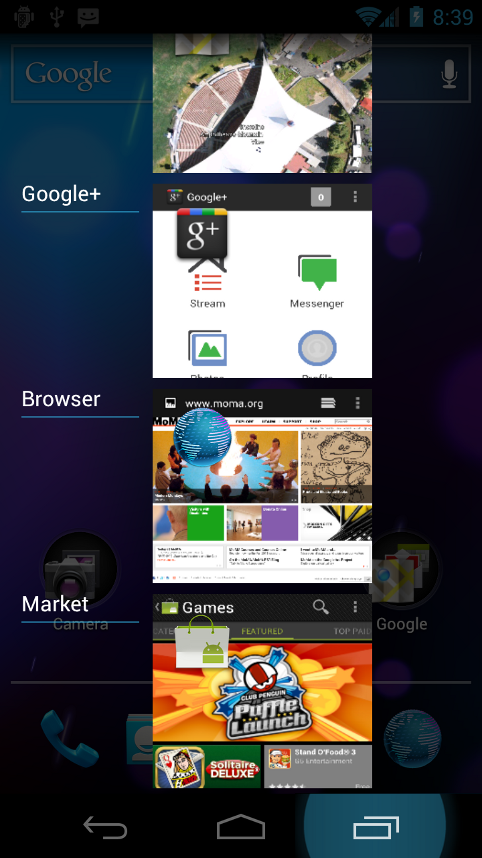
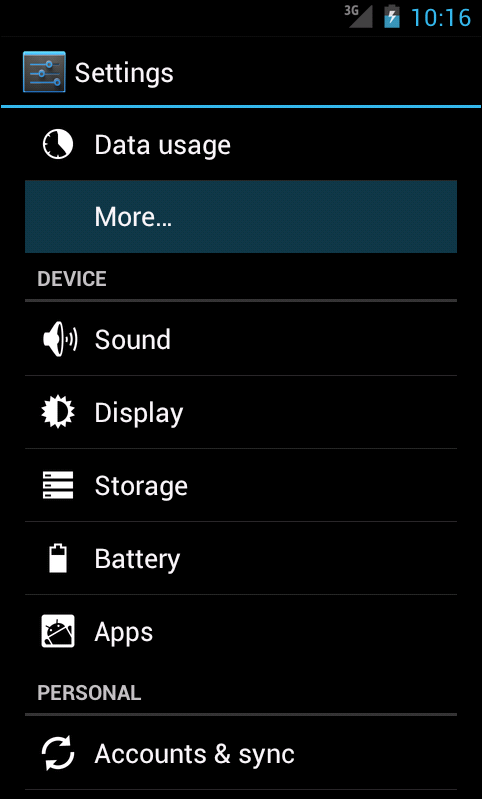
Back to the home screen, Google apps are now resizable and that functionality will be opened up to developers. The familiar home and back buttons are rejoined by the Recent Apps button from Honeycomb. This multitasking implementation looks and works very similarly as in the tablet OS, with the added ability to kill individual tasks with a swipe. This was an oft lamented absence in Honeycomb, as the list of apps could get quite long after several days of use.
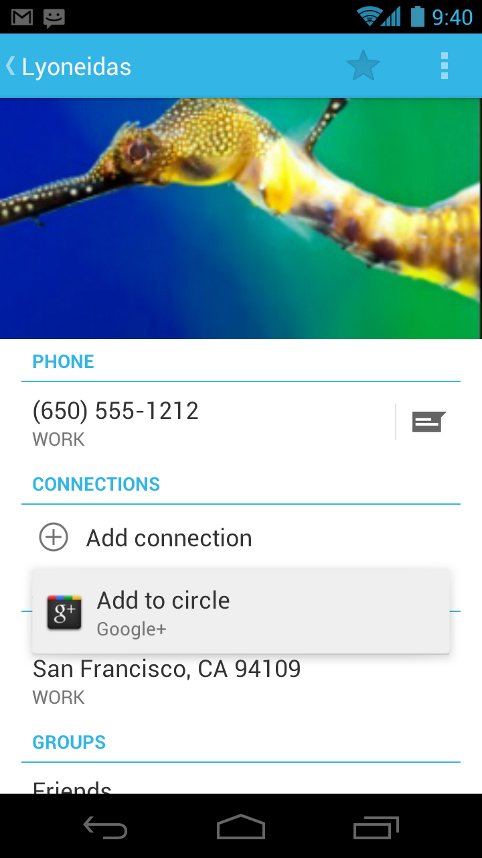
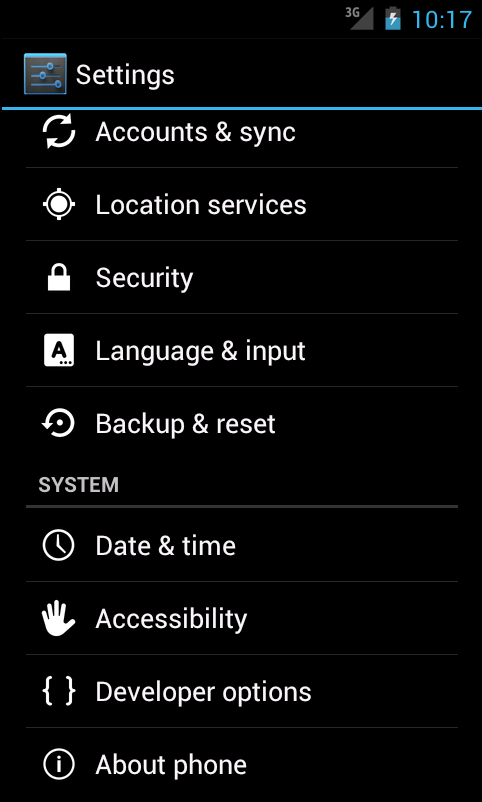
Phones are meant as communications devices so Google spent time on the Phone, Messaging and People apps. The People app replaces the Contacts app of old, and is livened up with larger pictures and a lot more data. Opening a contact’s profile reveals the typical list of numbers and e-mails, but it also includes connections through social media, and a swipe to the left reveals an integrated aggregation of that contact’s updates within those networks. They’ve also included a new Favorites tab that introduces a UI concept that we’ll see recurring in Android from now on, and it may look familiar to Windows Phone 7 users. The Favorites tab displays larger high resolution images of your most common contacts in a tightly aligned grid that is described as a ‘magazine style UI’ and bears a striking resemblance to the panels popular in Microsoft’s Metro UI.
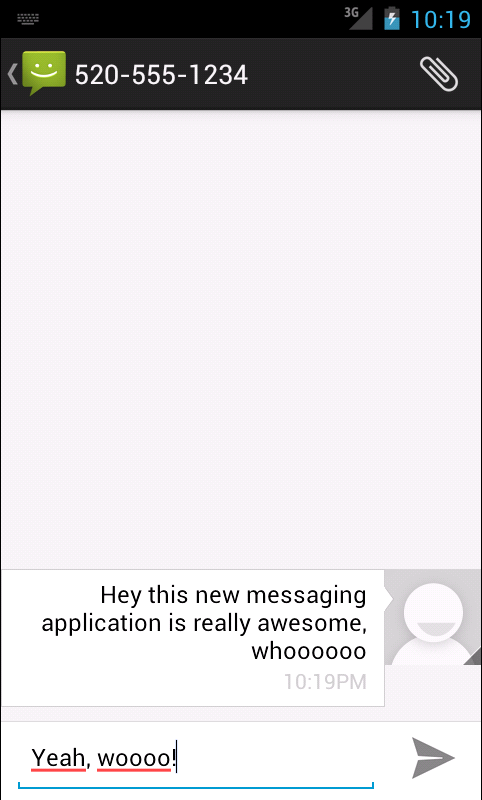

The Phone app has been updated with in-line visual voicemail (through Google Voice) amongst your call log, and a Favorite’s tab, as in the People app, that allows you to call common contacts with one touch instead of opening their profile first. Calling one of your contacts yields a new in-call screen that features a large profile image overlaid with call information and call functions.

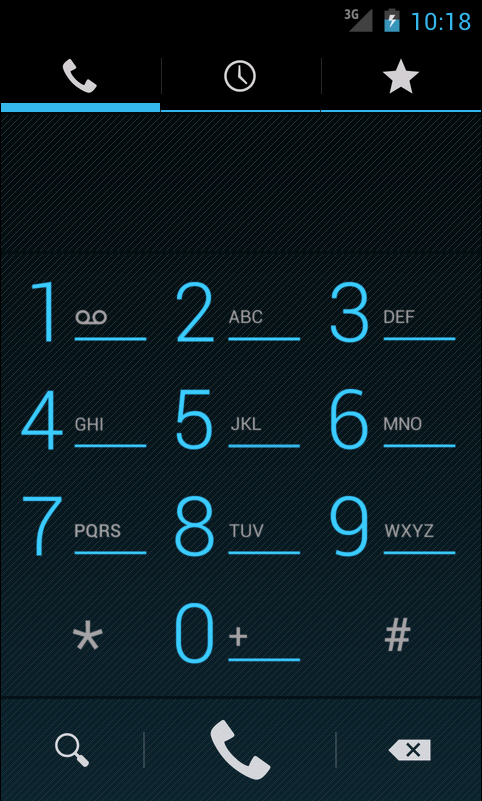
The Messaging app gets its biggest update from the improved keyboard, which has in-line spell check, improved word suggestion with easier to select options, and a refined way to add words to the dictionary. The voice recognition functions of Android have been improved and they’ve implemented an ‘open microphone’ experience that allows you to dictate long messages and insert punctuation, regardless of any pauses you might have while composing. The engine even supports emoticons.
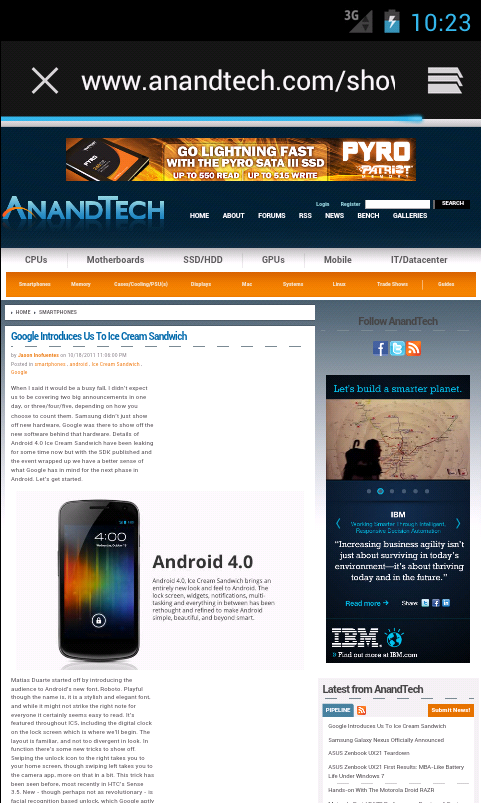
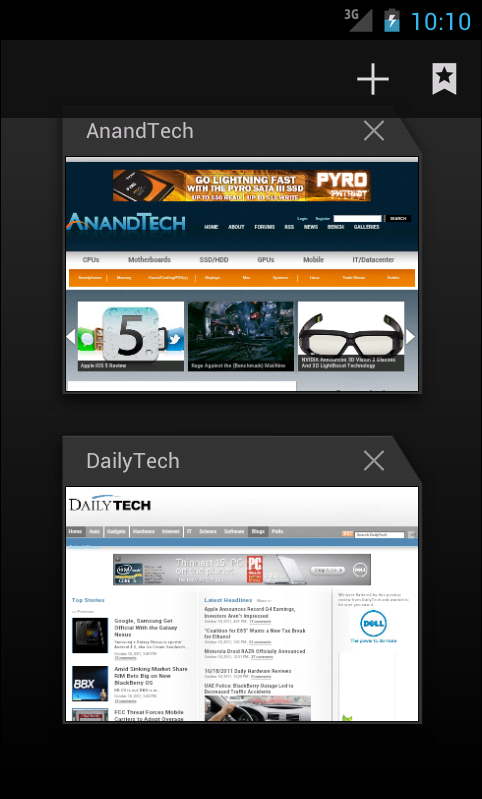
Screenshot of the article, within the article... How meta.
The Browser gets a new ‘Save for off-line reading’ function that is aimed at more than just storing articles, but can include things like boarding passes, and train schedules. It also gets a tab management system that mirrors the Recent Apps function. The stock android browser now also includes incognito mode, which no doubt will be used in conjunction with Flash for lots of scientific research.

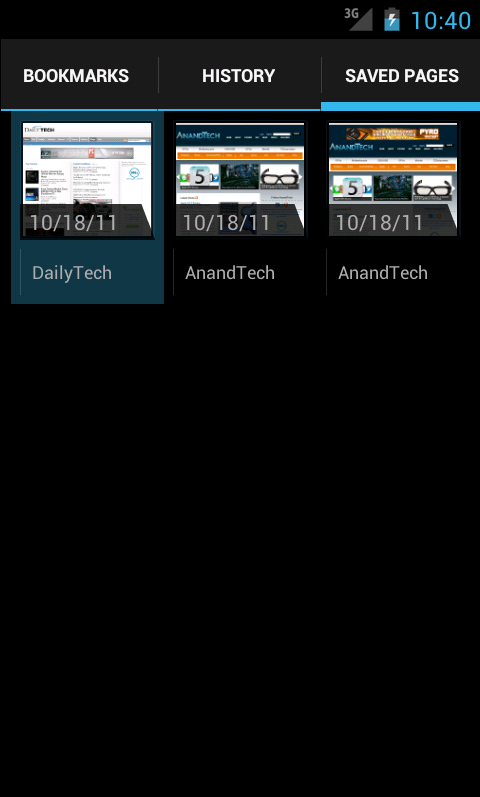
Every browser iteration from Android features performance improvements and this one is no different. Google notes that the stock Android browser gets much improved rendering speed through an improved and updated version of WebKit, and faster JavaScript performance thanks in part to an update to V8's crankshaft JIT engine. Google claims an improvement of 220% in Android 4.0 over Android 2.3 in V8, and 35% faster SunSpider 0.9.1 performance on the Nexus S alone. We look forward to testing out this improved Android browser and seeing what other improvements are lurking inside very soon.
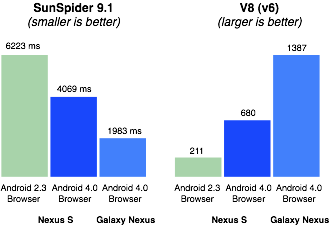
Google's Browser Performance Benchmarks (Courtesy Google)
In the emulator the benefits of this new version of WebKit are readily visible, where Android 4.0's browser scores 230 and 3 bonus points, compared with 177 and 1 bonus point in Android 2.3.5. The new browser also thankfully now exposes a desktop user agent switcher, something that has been missing for far too long from the stock Android browser.

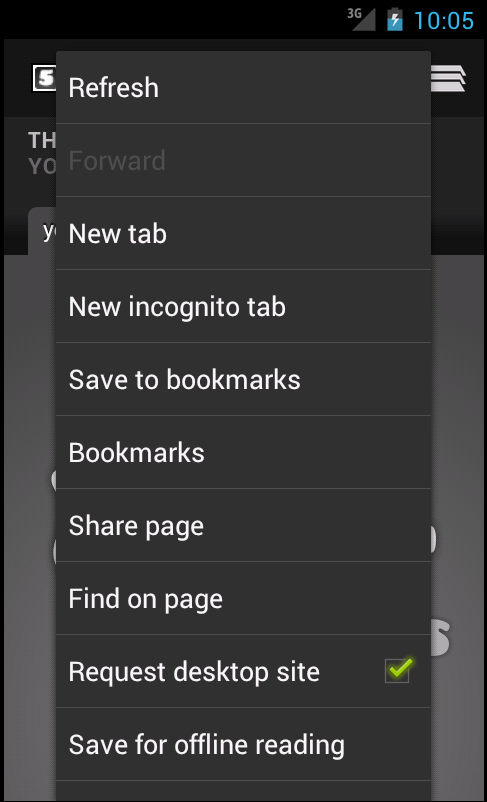
The Calendar app gets a new layout and features pinch to zoom for easily shifting from a broader to a more granular view of your agenda, and back again. They’ve extended the use of the swipe here to allow you to go back and forth between days/weeks/months. This same motion is found in the new Gmail app for browsing through e-mails quickly. And that Gmail app now gets two-line previews along with the other UI changes.
The Camera and Gallery apps have seen much work, and zero shutter lag exposure and a facial recognition function that keeps the image focused on identified faces are among the highlights. For Video the ability to zoom and continuously focus the shot while filming is a boon. And a new panorama mode allows users to easily create long shots with just a single motion, on the device and with a simple on-screen guide. Sharing from the redesigned Gallery app is a two tap affair, and the integrated photo editor allows cropping, rotation, red-eye reduction and the application of filters to captured photos. The Gallery itself is graced with that ‘magazine style UI’ and can be used to build Albums but can also sort pictures by location and faces.
NFC features prominently in Google’s plans with Google Wallet, and gains added functionality with Android Beam, which allows sharing of everything from files to links between two NFC enabled ICS devices.
That was certainly a lot to go through, and there’s no doubt more to cover another time, for now, we can’t wait to get our hands on the Galaxy Nexus to find out what Ice Cream Sandwich feels like in action. And in the meantime we’ll dig around the readily available SDK to see what there is to see. November’s going to be a great month to shop for phones.
Source: Android 4.0 Highlights



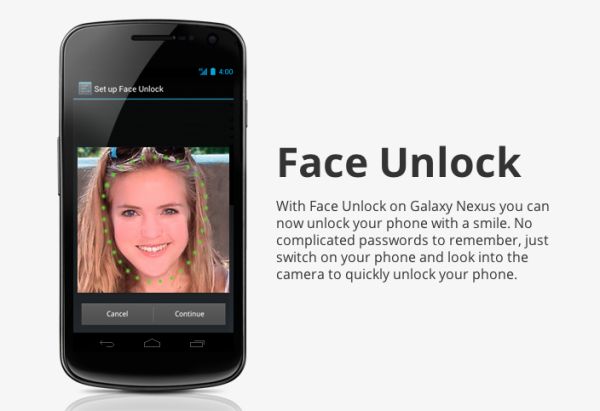
















36 Comments
View All Comments
piroroadkill - Wednesday, October 19, 2011 - link
Noo!I much prefer physical rather than capacitive buttons. Having them smushed into the screen, taking up space all the time, is even worse.
One of the design flaws in Honeycomb, I always thought, now it's carried over to ICS.
Johnmcl7 - Wednesday, October 19, 2011 - link
While I like having physical buttons, the problem with Android has been the complete lack of consistency even within the same manufacturer with phones have different number of buttons and different orders making changing between phones frustrating as you get used to a certain order and number of buttons. The N900 has no physical buttons and a consistent interface where all applications have the same pop up close, back, multi-task and menu buttons which works fine.John
v_coriander - Wednesday, October 19, 2011 - link
@piroroadkillICS 4.0 has a different story of the buttons to Honeycomb.
As mentioned in the Keynote event, the on-screen buttons will be disappeared in some situations. For instance, while watching video or browsing photos. In such way, users could take full advantage of the 720p screen.
Dominic
chris1317 - Wednesday, October 19, 2011 - link
Will ICS recieve the full review treatment that IOS5 has just had? Im keen to see reviews of both ICS and the Galaxy Nexus once available.xype - Wednesday, October 19, 2011 - link
If not more, it will probably be hard to get real comparisons with previous versions done, seeing how only two of the Android phones are going to get 4.0 (for the time being, at least) and most models are not going to run both.phoenix_rizzen - Wednesday, October 19, 2011 - link
Sony Ericsson Xperia 2011 phones (currently running Android 2.3.x) are slated to get Android 4.0.0 before the New Year.Should be easy to get a hold of a couple of Arcs, Neos, or Pros to do comparisons between 2.x and 4.x.
JasonInofuentes - Wednesday, October 19, 2011 - link
We will do what needs to be done. And given that this was 1,000+ word unpacking of the preview, I imagine there's a lot of words left.jiffylube1024 - Wednesday, October 19, 2011 - link
I watched the keynote announcement live on Youtube last night, and despite a few technical problems with the demo there was a lot to get excited for.Google seems to have really hit its stride with ICS - it's quite a departure from iOS in the look and feel department. They seem to have taken bits and pieces of ideas from WebOS and even Windows Mobile 7 with their multitask switcher (and flick to kill and app gesture) and larger picture tiles for users in contacts, respectively.
All of the improvements to Android were necessary and look to provide great functionality - better keyboard, better browser [improved tabbing, sync of Favourites with Google Chrome on desktop, 'save to view offline'], vastly improved multitasking (with large "Alt-Tab esque" previews), easier folder re-organization, faster camera access & camera access from the lock screen.
To steal Anand's expression, Google just Conroe'd the phone market (in my opinion)!
Now we need to wait for the official launch date and figure our if and when it's coming to older phones. There have been rumblings posted that Google is not happy with the fragmented nature of Android on smartphones; here's hoping that Android 4.0 ICS is available on phones from at least the last year or two!
jiffylube1024 - Wednesday, October 19, 2011 - link
One more quick note from the presentation is that they mentioned that the Samsung Galaxy Nexus is 1280x720 and that 720p is the "default" resolution for Android 4.0 ICS. Here's hoping that it's still scalable back to the resolution that 99.5% of current Android smartphones run. They announced that it will be coming out in November, so I hope there's more updates on ICS' availability soon.JasonInofuentes - Wednesday, October 19, 2011 - link
So I have been thinking about this for a while. There's no doubt that Honeycomb's initial release was a buggy mess, and there's something to be said for basic growing pains, but something stood out in the TIMN interview with Matias Duarte: “Honeycomb was like: we need to get tablet support out there. [sic] So that was the mission, and it was a time-boxed mission. Any corner we could cut to get that thing out the door, we had to.”The iPad was introduced in May of 2010. The Xoom was introduced in January of 2011 (weird to think it's so young). We generally say that a product of this type takes 12-18 months, start to finish. That pegs Honeycomb's nascency as early as 2009, around when the Motorola Droid was first making its introduction. Something else happened in May of 2010, though. Matias left Palm and joined the Android team. And from this quote it sounds like he was there from the projects infancy.
I don't imagine that Google didn't have some tablet strategy in mind before the iPad was introduced, but I don't think they were prepared for the consumer fervor that accompanied the iPad, and that's why they brought Matias on board and why Honeycomb was a rushed iteration.
We're obviously very excited about ICS, as to your question about scaling up and down, Google has been aiming for resolution independence for sometime, and it's really up to the developers to build their apps with this in mind. The hope is that the framework and tools that Google is implementing with ICS helps make this an easy thing for devs to do.
As for ICS showing up on older hardware? Three things need to happen, first it needs to be ported to multiple chipsets, an easier thing to do when the code is open sourced. Second, the xda-developer community has to take on the challenge of doing it themselves, a lot of hardware from the past 18 months won't make the cut. Third, demand on hardware that just missed the chance (SGSII for instance) needs to be high, and that means we can't all stick our hands in our pockets and wait to upgrade till an ICS phone we like hits the market.
Thanks for the comment, sorry for the wall of text reply.
Jason